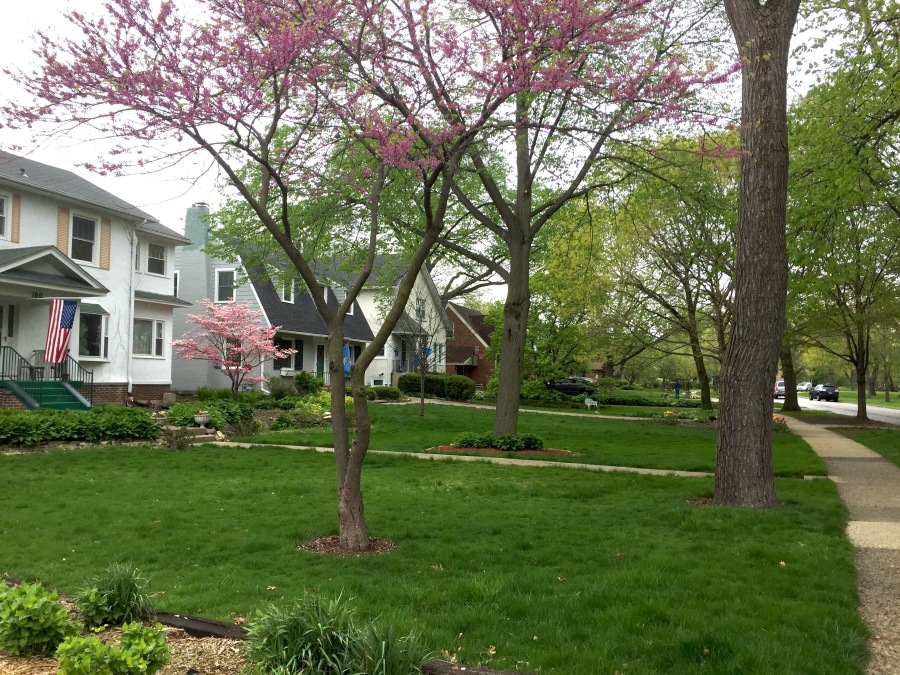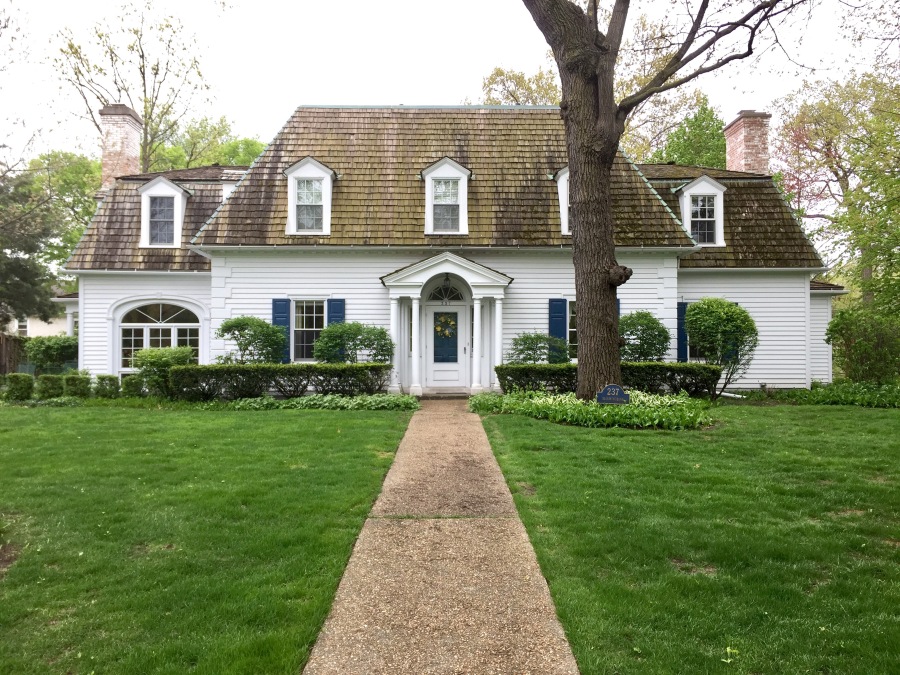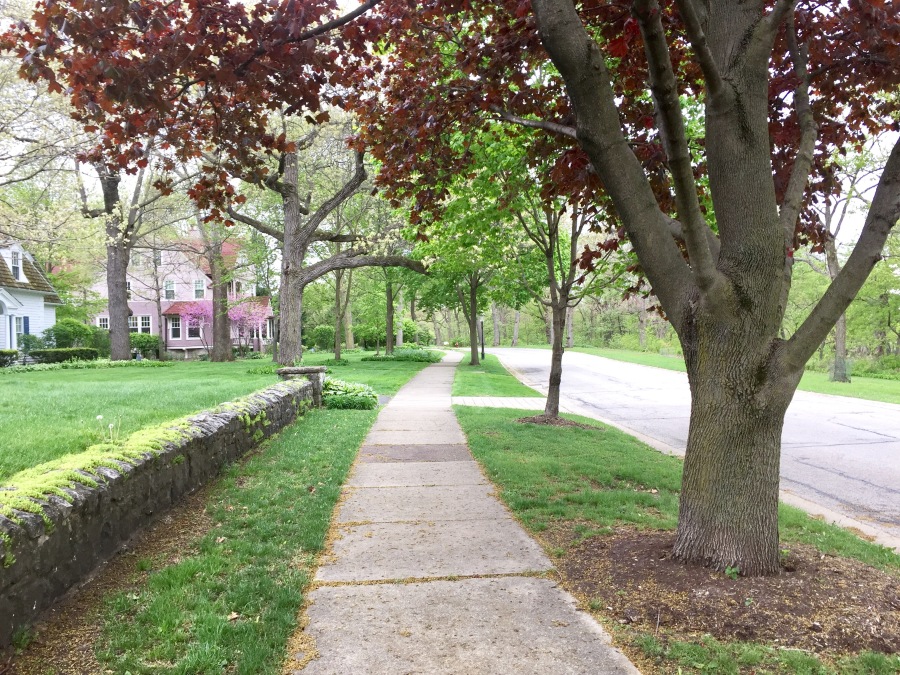On a recent visit to Chicago (where I’ve now moved!), I found myself in the western suburbs with an open morning, so I headed straight to Riverside, Illinois. I’ve spend a fair amount of time in downtown Chicago, but the suburbs are a different place entirely, especially if you’re on foot. Riverside is a cornerstone in the history of planning suburbia and I had to see it for myself.

Architect William Le Baron Jenney designed both the L. Y. Schermerhorn House, top, and the water tower, above.
Riverside dates from 1869 and is a train commuter suburb west of Chicago (today it is about a half hour via the Metra or by car). It was designed by none other than Frederick Law Olmsted, of Central Park fame (or Volunteer Park if you’re in Seattle) and his partner, Calvert Vaux. Rather than following a grid, the streets echo the curves of the Des Plaines River and there are a multitude of tiny parks at street corners. Sound familiar? If you are so lucky as to live on a curvilinear suburban street, you may have Olmsted and Vaux to blame. That is just the beginning of the intriguing design features implemented in Riverside. It was encouraged that homeowners not places fences or hedges between front yards, thus creating a continuous green landscape effect. All of the lawns are sloped up slightly, minimizing the visual of the street and maximizing the visual of the lawns.
Of course, it isn’t just the landscape design that is drool-worthy. A number of Chicago’s premier architects designed houses for the neighborhood. William Le Baron Jenney, perhaps best know for designing the first steel framed skyscraper, led the completion of Olmsted’s plans and designed multiple buildings, including the centrally located, fairy-tale-esque water tower. Other architects to design houses for the neighborhood included Frank Lloyd Wright, Joseph L. Silsbee, Louis Sullivan, R. Harold Zook, and William Drummond. The neighborhood as a whole is a National Historic District (it was such an early district, the nomination form, itself, is practically historic!). Two houses in Riverside have National Landmark status in their own right: the Avery Coonley House and the F. F. Tomek House. Six additional buildings within the historic district are also listed as local landmarks.
Riverside is not just a nice Chicago suburb, it was an influential step in the development of modern suburbia. But what else? Actually, despite all of its fascinating features, some of its design elements are slightly dated. Try to drive a car in Riverside and you will realize quickly that Riverside was not designed for cars (re: train commuter suburb. This was 1869, remember). The odd not-quite-round-abouts are mystifying to a passer-through (someone local tell me if there are neighborhood rules!). And the sidewalks, while designed nicely for walking to your house from the train, are sometimes on one side only and can be tricky to navigate for a wandering neighborhood admirer. That said, the carriage houses provide substantial and nicely tucked-away driveways and garages, something that you don’t see in early 20th century layouts like Ballard, in Seattle, were modern cars don’t fit in the tidy little sloped garages.
Riverside is a beautiful and unique suburb, and a captivating glimpse into the development of suburb planning. It is well worth the visit, particularly a visit that allows time for one of several recommended walking loops (a museum with maps is located adjacent to the water tower) and that incorporates traveling to and from the community by train.

The sloped lawns and lack of hedges provide a spacious landscape.

Tudor / English Cottage Revival style house

1869 Trowbridge House, design by the firm of William Le Baron Jenney

1908 Coonley House, Frank Lloyd Wright


Dutch Colonial meets Arts & Crafts


1904 Avery Coonley “Thomcroft” House, architect William Drummond

1869 Dore Cottage, architects Olmsted, Vaux & Co.


What a lovely mix of styles you found on Riverside’s streets!
LikeLiked by 1 person
Yes, it’s true! There’s a really nice mix of styles. I wonder how Frank Lloyd Wright felt about that 🙂
LikeLiked by 1 person
I absolutely love the Tudor style! It’s such a specific and striking look for a house that makes it so much cozier to me!
LikeLiked by 1 person
So agreed! Cozy is the perfect word for Tudor. It’s hard to go wrong with a little Tudor/English Cottage Revival!
LikeLiked by 1 person
[…] One of the first suburbs anywhere was Riverside, Illinois, and Susie Trexler took her camera and her solid understanding of architecture and history out to visit it. Read Exploring Suburbia’s Roots: Riverside, Illinois […]
LikeLiked by 1 person
The best memories of growing up at 218 Hedrick rd. Beautiful town.
LikeLiked by 3 people
That’s so cool, Nadine! Riverside would be an amazing place to grow up. Whether intentional or not, I suspect the design lends itself well to neighborhood and kid activities.
LikeLiked by 1 person
Fascinating and evocative. Here in Australia, our Capital, Canberra was designed with the same circular streets by Walter Burley Griffin. We used to joke, “If you see the building you want over there on your right, turn left!”
LikeLiked by 2 people
Ha, I love the joke! I do remember hearing that Griffin did a design in Australia but didn’t realize it was so similar to this one. I will have to look it up!
LikeLiked by 1 person
Lovely synopsis. Thanks for sharing. I grew up in Riverside in the 1960’s & 70’s. At that time I found it so small and boring. Vanilla. Now, I see what an amazing place it was to grow up. Love the rich history.
LikeLiked by 3 people
Thanks, Kathleen! That’s great–the kid perspective! I can see it, but I’m glad to hear you appreciate it more now. I can only imagine it would be a great place to grow up. Today, probably far better than the newer suburbs!
LikeLiked by 2 people
I grow up in N.Riverside, and enjoyed riding my bike throughout the village.
How ever at night, you could not see the streets, and had to be home
before dark. No street lights, and no vision of where you were going.
I guess that is how they keep people from loitering in the area.
LikeLiked by 1 person
Thanks Josie, I love hearing the perspective of people that grew up in Riverside! I suppose everywhere was just darker when Riverside was designed as it was pre-electricity. Interesting that it stayed so dark, I wonder if they kept modern lights out to retain more of the historic character.
LikeLiked by 1 person
I grew up in the next town North Riverside. Always loved walking around and riding my bike Around Riverside with my friends. It’s a beautiful town spent many years having fun and enjoying it. I do believe they kept the modern lights out for just that reason to keep it as original as possible. Years ago we had to keep out parking lights on so in high school everyone looked for the car lights and knew where the parties were
LikeLiked by 1 person
Thanks for the feedback, Kathy! I love the idea of biking around the Riverside area as a kid, seems like the streets would be fun for that. I also suspect you’re right about the lights. That’s such a funny solution to the lack of lighting!
LikeLiked by 1 person
It really was fun. I don’t believe you still need the parking lights on to park at night now they changed that years ago. I know back then there were many dead batteries. Here is a group that makes the decisions about preserving Riverside and I’m pretty sure made the light decision of my memory is correct. http://www.olmstedsociety.org/
LikeLike
That makes sense. I’ll check it out, thanks!
LikeLiked by 1 person
wow! they’re all beautiful! makes me want to pack up my bags and move.
LikeLiked by 1 person
Haha me too! There are some gorgeous houses in Riverside.
LikeLiked by 2 people
I’m so glad I got to grow up at 199 Northwood Rd!
LikeLiked by 1 person
A feast for the eyes. How lucky to have all these styles on offer for inspiration. That water tower alone is so pretty and the houses look they have come from an American movie set.
LikeLike
The water tower definitely sets the tone. The diversity of styles is great–I’m surprised there hasn’t been a movie shot here!
LikeLiked by 1 person
It is probably on Hollywood’s radar, even so!
LikeLiked by 1 person
[…] Exploring Suburbia’s Roots: Riverside, Illinois (got so much local feedback on this one, I loved it!) […]
LikeLike
[…] mimics the design of idealized suburbs of the late nineteenth century–for example, that of Riverside, Illinois. The goal for the architects and landscape architects was one of integration and cohesion between […]
LikeLike